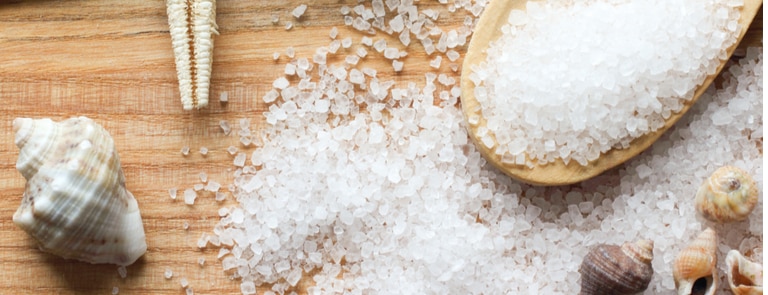15% off €35 or 20% off €45
The benefits of using sea salt

Have you ever wondered what about all the hype over sea salt? How it differs from table salt? And why it sits in pride of place on dining tables, kitchen shelves and bathroom cabinets alike?
Then you might be interested to learn that sea salt is not just great for cooking with – it also has a number of other uses outside of the kitchen.
What is sea salt?
Sea salt is a natural salt, derived from evaporated sea water.
Sodium crystals, which are left behind once the water has evaporated, form the sea salt that we have all come to recognise.1
Sea salt, just like all salt, is a mineral, mainly made up of sodium chloride (NaCl).2
Sea salt can also contain traces of minerals such as potassium, magnesium, calcium and other nutrients. It contains roughly the same amount of sodium as table salt.3
How much sea salt should I consume?
No matter how wonderful sea salt is sprinkled on your food, you do need to be mindful of your salt intake.
Too much salt can have a detrimental effect on your blood pressure and heart health.
Here is the NHS guidance for how much salt you should consume each day4:
Recommended daily consumption of salt for adults
No more than 6g of salt a day (2.4g sodium), which is the equivalent of around 1 teaspoon.
Recommended daily consumption of salt for children
The recommended daily consumption of salt for children varies according to their age:
- 1 to 3 years - no more than 2g salt a day (0.8g sodium)
- 4 to 6 years - no more than 3g salt a day (1.2g sodium)
- 7 to 10 years - no more than 5g salt a day (2g sodium)
- 11 years + - no more than 6g salt a day (2.4g sodium)
- Babies under 1 – very little salt, since their kidneys are not yet able to process it properly
Find out more about hidden salt in food to work out if you might already be consuming more salt than you think.
Benefits of sea salt
But when you do reach for salt, here is why sea salt makes a great choice:
-
Natural sea salt is less processed than table salt
Rock salt, especially that which ends up as table salt, take a lot of processing.5
It is mined in its solid form underground, and then subsequent processes remove “impurities” such as naturally occurring minerals.
Potassium and calcium are commonly found in rock salt, and these are often removed and replaced with additives, such as anti-caking agents, to prevent clumping.6
-
There are beneficial trace minerals in sea salt
Refined salt has most, or all, of its trace elements removed.
Some of these trace elements contribute to keeping our bodies healthy, and unrefined salt is a source of trace elements, such as magnesium and potassium.
These particular elements work with the sodium in salt to regulate your body’s nerve and muscle impulses.7
These elements can be consumed through the food you eat, or through your skin, such as in a Dead Sea salt bath.
However, it should be noted that sea salt itself offers little health advantages and the trace minerals it contains can be easily found in other, healthier foods.8
Iodine is also sometimes added, creating iodized salt, which is part of a worldwide campaign to tackle iodine deficiencies.9
-
The texture of coarse salt is more natural than refined table salt
The crunch of sea salt on a salted brownie, the burst of flavour in savoury dish, the ease with which you can pick it up with your fingers and sprinkle it into your cooking…
There are so many reasons why the coarse texture of sea salt is brilliant for use with food.
Table salt, on the other hand, has been heavily refined, so that it can pour easily from a salt cellar.
This is why chefs worldwide love cooking with sea salt.10
- Sea salt for health and beauty
We already know that sea salt does not just live in kitchens - it also pops up in body scrubs, bath soaks, hair sprays, shampoos and a host of other products.
It is thanks to both its texture and unique balance of beneficial minerals that it is such a versatile salt to use, both inside and outside of our bodies.
Relaxing in a dead sea salt bath
Taking a warm bath almost always brings relaxation and comfort, and there is nothing like setting up that special bath to sink into at the end of a stressful week, a long run, or to warm up on a cold winter’s night.
There are many benefits to having a sea salt bath and at Holland & Barrett, we stock a wide range of natural bath bombs and salts which you can add to your bath to bring extra relaxation and soothing properties.
Dead sea salt bath salts are known for their particular combination of minerals which can gently help to soak away tension, help soothe skin and relax the body, leaving you ready for a good night’s sleep.
Last updated: 24 March 2021
- https://www.heart.org/en/healthy-living/healthy-eating/eat-smart/sodium/sea-salt-vs-table-salt
- https://www.saltassociation.co.uk/education/salt/
- https://www.heart.org/en/healthy-living/healthy-eating/eat-smart/sodium/sea-salt-vs-table-salt
- https://www.nhs.uk/live-well/eat-well/salt-nutrition/
- https://www.heart.org/en/healthy-living/healthy-eating/eat-smart/sodium/sea-salt-vs-table-salt
- https://121dietitian.com/salt-awareness-week-sea-salt-rock-salt-healthier-options/
- https://theecologist.org/2009/may/01/what-type-salt-best
- https://www.heart.org/en/healthy-living/healthy-eating/eat-smart/sodium/sea-salt-vs-table-salt
- https://www.who.int/nutrition/topics/idd/en/
- https://www.cornishseasalt.co.uk/pages/salt-is-good-for-you



